

 The Accurate Reloading Forums
The Accurate Reloading Forums  THE ACCURATE RELOADING.COM FORUMS
THE ACCURATE RELOADING.COM FORUMS  Guns, Politics, Gunsmithing & Reloading
Guns, Politics, Gunsmithing & Reloading  Reloading
Reloading  Precise Bullet Seating?
Precise Bullet Seating?Go  | New  | Find  | Notify  | Tools  | Reply  |  |
| one of us |
Never paid that much attention to it, even though I have been reloading since the mid-60's, and always thought it to be the easiest part of hand loading. That is, until I recently started shooting a lot of paper. (In Iowa, you can shoot CF's on paper and coyotes....that's about it.) Precise bullet seating for me has been a "hit & miss" PIA. Any difference in bullet ogives seems to throw the seating off by as much as .005", and that HAS made a difference in POI with all my rifles. So, how do you guys who get your depths right down to a thousandth or two do it? ************************ Our independence is dying. | ||
|
| One of Us |
the issue with mass-produced bullets, well one anyway, is that there is not just one set of tungsten-carbide dies used for each design. Sierra Match Kings, for instance, have three final point-up dies forming the final nose shape and spitting them in one bin by the thousands an hour. Not bad-mouthing Sierra in any way; that is the economics of the business. When I started shooting Hunter Bench Rest about 1988 I shot them exclusively, and could get groups under 1/4moa out to 300 yards with a Leupold 36X scope. Sinclair sells this little tool that looks like a six-sided (hex) nut. It has different caliber holes in each of the flats, and they are also slit along the center from flat to flat. Select your caliber, and slide the flat opposite that hole on dial calipers. As you set each bullet on the jaw of the caliper the nose goes into the hole. When it bottoms out (hold that thought)you slide the caliper closed and get a reading. MK 150's were THE bullet at the time, with 4895 powder. They would have three different length readings. A couple other guys and I would buy 10,000 after the match season was over and each sort our third into three piles. Each of us took one pile, and we squared up on the $$$ difference. No one length shot any more accurately, but they would shoot into slightly different points of impact. Bench Rest rifles shoot more accurately (all rifles do) if you eliminate the variables you can. Minimum dimension chambers and arbor press dies work the brass the least, so case life is awesome. One lot of powder, one box of 1000 primers, and match the ogive as I said. Carefully seat a bullet long, and keep easing it into the chamber, and then seating it .010" deeper. until you stop feeling resistance. Set your seating die there. Take another case and seat a bullet that depth, then Sharpie the nose and chamber it. You should see six (land and groove) marks evenly spaced on the nose. That is zero freebore. Most of us would turn the die in .010" and shoot five. Ditto one more time for a total of .020" "jump" to the rifling. Back to the ogive measurer. IIRC those Sierras had an ogive measurement of .013", .016", and .020". Very small difference, but if you are shooting them at .010" jump and used a .013", the .020" will be just .001" off the lands chambered. Custom bullets. like the JLK or Bibbs will be made in lots of 1020+/- to allow set up each time by hand with one set of dies. I shot a lot of JLK and the variance was .0002" You can only guesstimate the wind and mirage, so eliminate the variables you can. Match brass, bullets, dies and minimum tolerance rifle and loading techniques. This is a bit lengthy, but I always wondered "How'd they do that?". It's how a guy with a 10 1/2lb 6PPC can shoot groups under a quarter of an inch at 300 yards on his good days. Class is dismissed... Rich | |||
|
One of Us |
I think Idaho has covered the bullet part of consistant seating very well. However there is the other step which is taking a good set of bullets and getting consistant seating depth when putting them in the case. IME the seating depth will vary depending upon the seating pressure necessary to seat it in the neck. IOW if you are seating a string of bullets and notice a difference in the amount of pressure it takes to seat the bullet, that will cause a difference in the seating depth. If you encounter more resistance then the OAL will be longer by as much as you mention .005" or more and if the bullet slides in easier then the bullet will seat deeper and the OAL will be less. This may be because of the linkage in your press absorbing and compressing more or for some other reason, but it definitely happens. Having a good seater like the Redding, Forster or RCBS Comp Seater definitely helps. But after that it will depend upon how consistant you have prepped the neck to receive the bullet. I have seated an entire set of 50 bullets with a variance of .002" or less as measured by a comparator. The methods I use may not be the only way to get consistancy but they work for me and a very consistant seating depth has helped my accuracy and extreme spread on velocity. First you have to have a consistant bullet grip. The Lee Collet Neck Sizers used correctly will give you very consistant inside neck diameters. I don't use dies with expander balls because of lube in the neck and runout, but they may work as well. The bushing type of dies have a problem in that any inconsistancy in neck thickness will be pushed to the inside (unless you keep the expander ball in and why would anyone do that) and that will make for inconsistant ID of the neck. Even if you outside neck turn it is almost impossible to turn to 100% consistant neck thickness. The reason I know this is that I use a bushing die for my 338RUM and turn to .012" using a Forster hand turner and that neck thickness will vary .0005" to one side or the other on some of the necks. That means there will be a .001" difference in bullet grip between the thinnest and the thickest necks. A set of pin gauges is indispensable in determining how consistant the actual dimension on the inside of your neck is 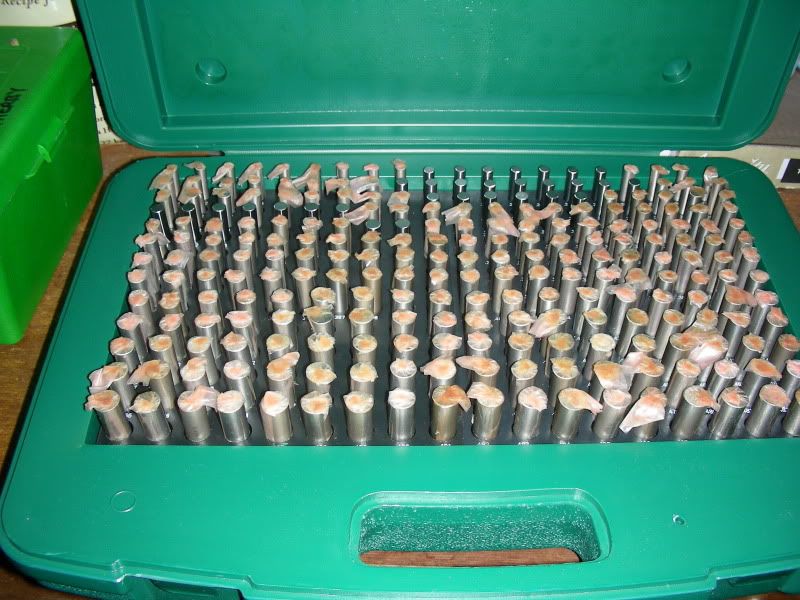 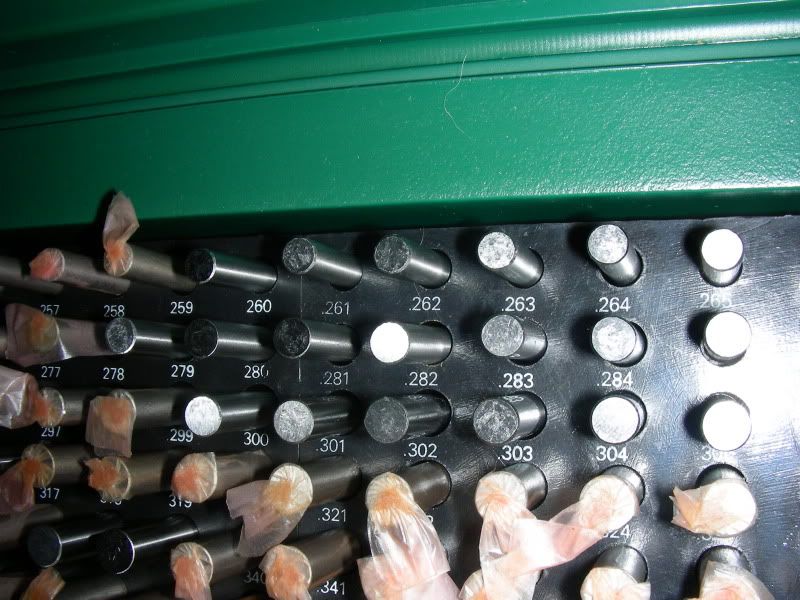  with the last 50 of my 338RUM cases that I turned, sized and prepped, I took the .337", .336" and .335" pin gauges and inserted them into the case and found that 80% the .336" fit perfectly for a .002" bullet grip. For the rest, some were slightly larger and the .337" would barely fit and on some the .366" would not fit but the .335" would for a slightly smaller ID. Right then I decided I needed to order a custom Lee Collet from Lee because all of the cases I size with the Lee Collet have the exact same ID. Then you need to prep the inside of the neck. After sizing, I clean the inside with scotchbrite or steel wool 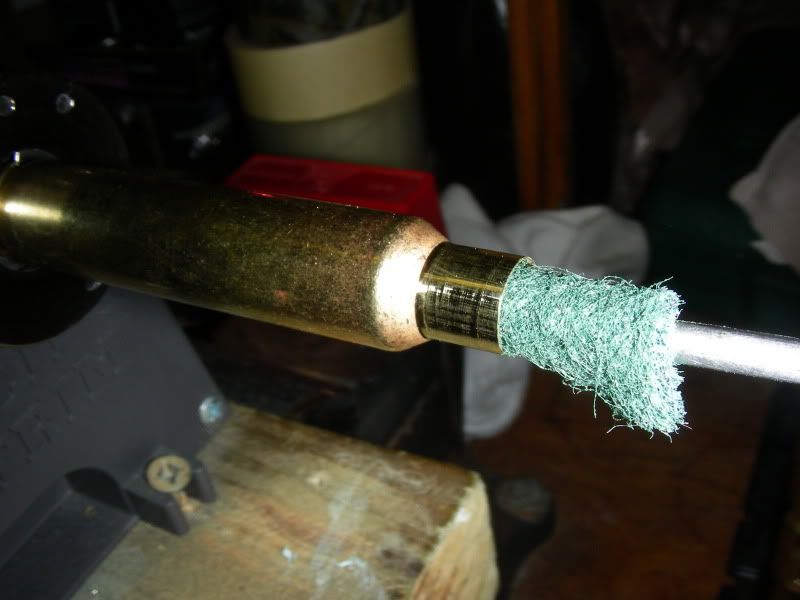 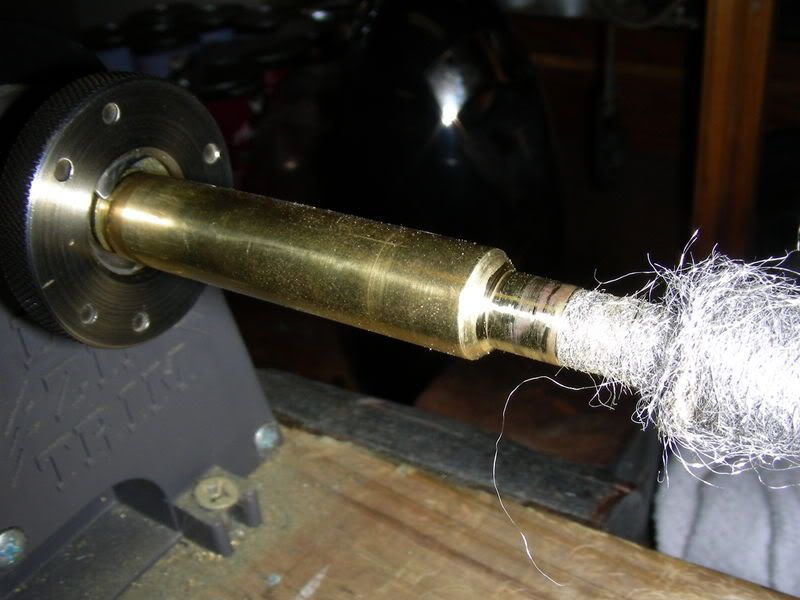 sometime both and then coat the inside with Mica 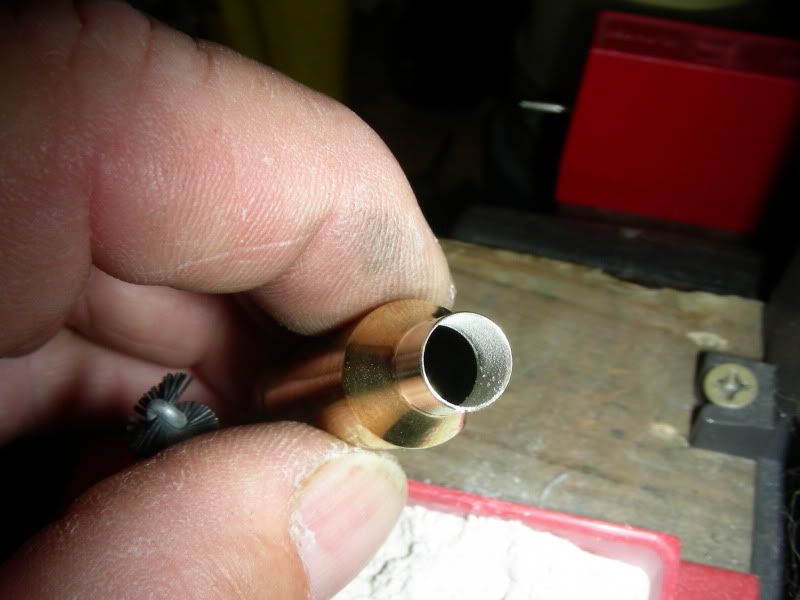 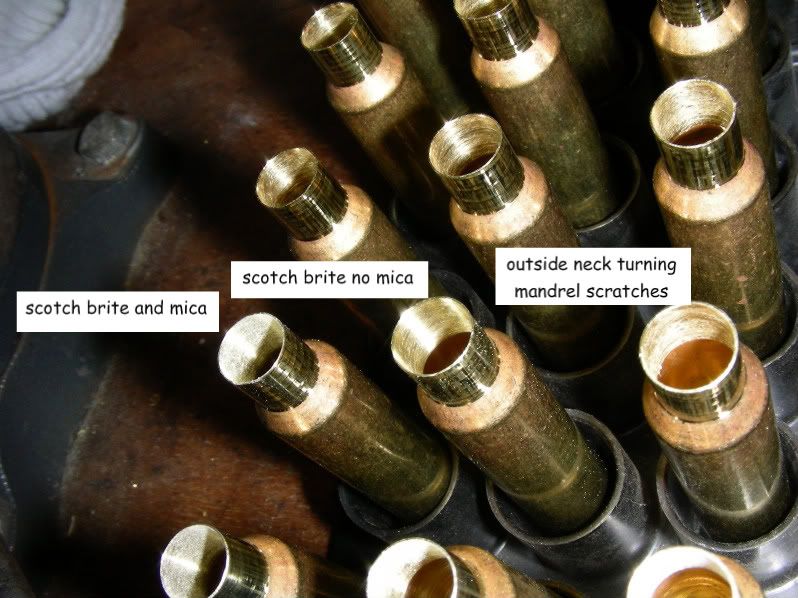 Since I started doing all this I have been getting very consistant seating depths and single digit velocity variations on multiple shot strings (6 shots or more). But I'm just the local CPN (case prep nut ____________________________________ There are those who would misteach us that to stick in a rut is consistency - and a virtue, and that to climb out of the rut is inconsistency - and a vice. - Mark Twain | Chinese Proverb: When someone shares something of value with you and you benefit from it, you have a moral obligation to share it with others. ___________________________________ | |||
|
| One of Us |
WOW!! I wanted to respond, but after reading Idaho and woods I'll have to think if I can add anything. Case preparation consistenecy is everything in my opinion. | |||
|
| One of Us |
I think if Rich was shooting Hunter Class BR, with a 36X Leupold scope, he was cheating. NRA Patron Life Member Benefactor Level | |||
|
| one of us |
Hey DB, I do it a good be different that the above posters. First I verify that the Tip of a Bullet out of the Box does not make contact with the inside of the Seating Stem. Just unscrew it from the Die and set the Bullet in it. If the Bullet is wobbling and/or not making contact with the Ogive all the way around, you will never be able to Seat the Bullets accurately. This is typically a problem with the Super Sleek, High Ballistic Coefficient Bullets. If it happens, you can contact the folks that made the Dies and they can normally send you a Seating Stem which will correct the issue. You can occasionally drill the Seating Stem a bit deeper. This is not as easy to do as it seems. Or you can wax the Bullet tip, stick a small drop of 2-part Epoxy in the Seating Stem, press the Bullet in place and let it dry. The trick here is devising a way to hold the Bullet Straight with the Seating Stem during the drying, or every Bullet will be Seated at a slight skew. Once the Bullet sits in the Seating Stem correctly, then I simply convert OCL to ODL and continue Seating Bullets. No "Thingys" needed. Best of luck to you. | |||
|
| One of Us |
I've noticed much more consistant bullet seating with regard to force needed to seat bullets and very consistent OAL like Woods has eluded to after annealing the cases. The annealing returns the brass to "like new" condition; softer and consistent from case to case. I have just been using my standard RCBS seating die with the decapping pin and expander ball removed. I do neck turn my brass and feel it has helped as well. | |||
|
| One of Us |
Hot Core..... Really good link! Good job! I always wondered how to make adjusting the seating die from loading to loading easier........ | |||
|
| One of Us |
Sorry but there is a lot of BS on here about this.. First I machine turn the outside necks on a lathe using a oil mixture developed by Speedy (STP and tranny fluid) for his own cases as well as customers (make sure to clean by boiling for a minute or two in a Dawn soap mixture then pour out the cases into a colander remove and let dry. When doing this the mandrel that goes into the case does not generate much heat which means little or no expansion and the necks are absolutely perfect on the outside. Now get the John Buhay bullet measuring tool sort bullets by bearing surface, then get a set of Wilson dies and this tool http://www.benchrest.com/hnh/ to measure and correct if necessary any run-out. There are a lot of other tricks but this should get you started. | |||
|
| One of Us |
If what you want is consistent seating depth, let me ask you "Consistent with what?" Let me also make an assumption (with all the dangers of any "ass-u-me'-ption" situation). I assume you mean consistent distance from the ogive to the origin of the rifling? As you have noted in your original post, that distance varies as the ogives of the bullets vary....with many makes of bullets as much as .006" to .008". How did you learn the ogives vary? By using a measuring device in which a rod or a "nut" with a hole approximately the land size of the bore is used as a contact point for the ogive end of the bullet. The variations in the readout of the measuring device actually indicate how far the bullet goes into the land-sized hole in the rod before the bullet ogive makes contact. To get a consistent distance of the loaded bullets from the rifling, then you are faced with two choices: One is to sort the bullets so that in each batch you load, the variation is held within limits you choose as acceptable. That could be 0.000" variation, .001" variation, .002" variation, whatever. The less the variation you'll accept, the greater number of groups of sorted bullets you'll have to have. The other is a seating tool which uses a hollow rod to seat the bullets, with the hollow in the rod being, again, the land diameter of the bore. That way, each bullet is pushed an amount into the case which is determined by the dimensions of the ogive exactly where the lands would contact it. Bullets which the measuring tool you used to sort would have measured as "longer" will automatically get pushed deeper into the case. Either method will work. I prefer the latter one, and make my own seating stems to accomplish that, for rifles where I find that degree of consistent bullet jump to be beneficial to that rifle's normal use. As an after-thought, though, the latter method does have an inherent potential problem...if the bullets are pushed different amounts into the case to obtain consisent depth from the rifling origin, the actual "capacity" of the case will vary in a practical sense. With a given powder charge, that may make some measurable difference in pressure and velocity from round to round. In short range target shooting (up through 200 yards) such differences probably won't have any measureable negative effect, but at longer ranges those differences may cause significant enlargement of "elevation groups". Then, one has to make a choice. Is the more consistent bullet jump enough benefit to overcome the enlarged variation in the powder burn? So far, I haven't finally determined the answer to that question for my own satisfaction. But it could mean going back to just sorting the bullets and only using the "alike" ones for each batch of loads. Every shooter's MMV. My country gal's just a moonshiner's daughter, but I love her still. | |||
|
One of Us |
Okay so I took the following measurements (love those pin gauges 338 caliber Redding Competition Seater stem opening .275" Hornady Comparator .326" Caliber .338" So the bullet has a certain amount of curve left and distance between where the comparator hits the bullet and where the bullet reaches full diameter. There probably will be some variance there. The seating stem hits the bullet at a significant distance from where the comparator will hit and if there is variance there, the comparator reading will be different even though the seating die has done it's job and seated the bullet to the same distance according to it's seating stem location. So if you are sorting bullets then they should be sorted according to the distance between where you seating stem hits and where the bullet reaches full diameter. AC's method of making a seating stem to fit the bullet would solve a lot of this variation if not all. The seating stem on the Redding goes in tight at the top and the bullet contact point drops down into a larger cavity so it would be an engineering feat to make a .338" wide seating stem and get it into the die, perhaps from the bottom if you take the lock ring off. It would be a simple matter to make a bullet specific seating stem to match the bullet perfectly with a bedding compound like MarineTex and wax on the bullet but there would still be the problem of inserting into the die and having the die work properly. How do you do it AC? ____________________________________ There are those who would misteach us that to stick in a rut is consistency - and a virtue, and that to climb out of the rut is inconsistency - and a vice. - Mark Twain | Chinese Proverb: When someone shares something of value with you and you benefit from it, you have a moral obligation to share it with others. ___________________________________ | |||
|
| One of Us |
As described in red above. But to go even a bit farther, that problem is a typical one of the reasons I have become more and more interested in shooting other than organized competition as i age. I have quit benchrest in particular because I find it tends to become a never-ending compulsive sport, where cleaning is a fetish, cartridge detail may become several other fetishes, perhaps even mild manias, and so on. I don't mean that in any insulting way. I have been infected as much as anyone with all of those manias. It is just that after many years of competition I asked myself one day...."and just how is this more fun than hunting or even plinking?" After thinking it over and over and over, I decided it wasn't. I'd rather go out in the field and try to read or guess the wind, try to improve my unsupported holds and let-offs, and try to learn to better estimate distances to the target(s) whatever those targets might be. Mild compulsiveness is a benefit to useful accuracy, but severe compulsions just take the fun out of it for me. Balance in all things is one of the true lessons of all the age-old wisdom systems. Best wishes.... My country gal's just a moonshiner's daughter, but I love her still. | |||
|
| one of us |
Thank goodness " I'M " not compulsive. A real thought provoking concept AC! | |||
|
| One of Us |
Start with a Sinclair Bullet Comparitor and a factory round of the desired caliber. Take a measurement of the round and use this as a starting point. Folks who make ammo have to make it to an average standard that has acceptable accuracy in most any arm, or the ammo won't sell. from that point, move the bullet out in whatever increments you prefer. I've found this to be a lot quicker than using a bullet seating depth tool. Yes, seating depth is impacted by the ogive which in turn, impacts accuracy. | |||
|
One of Us |
Excellent post AC and very insightful. I have a tendency to be too compulsive at times, but it will never be benchrest compulsive or competitive. I only compete with myself so I can win sometimes So until I am convinced that I can not improve upon hunting load accuracy any further, then I am doomed to continue to pursue the last little detail and buy and use all the "thingies" I can find. Perhaps I could be like HC and retrograde and see what I could accomplish with duct tape and baling wire Anyway, thanks for the post and I am off to find perfect bullets! ____________________________________ There are those who would misteach us that to stick in a rut is consistency - and a virtue, and that to climb out of the rut is inconsistency - and a vice. - Mark Twain | Chinese Proverb: When someone shares something of value with you and you benefit from it, you have a moral obligation to share it with others. ___________________________________ | |||
|
| One of Us |
Woods, Are your hunting guns custom built or factory? | |||
|
One of Us |
Both, I have a factory 22-250, 30-06 and 300 win mag and custom rebarrel 6.5 rem mag, 280AI and 338RUM ____________________________________ There are those who would misteach us that to stick in a rut is consistency - and a virtue, and that to climb out of the rut is inconsistency - and a vice. - Mark Twain | Chinese Proverb: When someone shares something of value with you and you benefit from it, you have a moral obligation to share it with others. ___________________________________ | |||
|
| One of Us |
What brand are your pin gauges? | |||
|
One of Us |
Go to CDC tools and click on measuring tools, then pin gauges and they are listed on the right. I have the .251" to .500" for $55.00 Well I just went through an eye opening experience. Decided to use a comparator and check some different bullets to see how consistant the bullet base to comparator was. I just took a sampling of 10 to 20 bullets: 130 gr Scirrocco 6.5 was +/-.002" 140 gr SGK 6.5 was +-.001" 200 gr Accubond .308 was +-.018" 180 gr Accubond .308 was +-.021" 160 gr Accubond .284 was +-.002" 150 gr SGK .284 was +-.002" 225 gr TTSX .338 was +-.002" (that's a pleasant surprise there) 180 gr TTSX .308 was +-.002" (another pleasant surprise) I know the Barnes bullets vary quite a bit in weight for a box of 'em, sometimes as much as 2 gr but evidently they have their bearing lengths close. The Accubonds were just terrible! There were some that were a consistant length but there would be groups at this length and groups at that length and some real short ones. Is there a better way to sort for bearing length than just a comparator? ____________________________________ There are those who would misteach us that to stick in a rut is consistency - and a virtue, and that to climb out of the rut is inconsistency - and a vice. - Mark Twain | Chinese Proverb: When someone shares something of value with you and you benefit from it, you have a moral obligation to share it with others. ___________________________________ | |||
|
| One of Us |
Woods, I think it's awesome if you are wringing 1/2 MOA out of your factory hunting rifles! That's what I have always tried to do and have with some of them. It must be your "compulsive" case prep that does it. Sorry to take the thread astray with the questions, but it seems to be heading that way anyway. Do you get better than that with your customs? | |||
|
One of Us |
I am nowhere near where I need to be yet. 1/2 MOA does happen but sometimes the rifles and loads will veer away from that and need to be tweaked again. The factory rifles are not typical in that the 22-250 is a heavy barrel Remington VLS and it should get 1/2 MOA and that has been easy to do, no trick for a varmint gun. The 30-06 is a Steyr which I believe is the most accurate out of the box rifle you can buy. The 300 win mag is a Beretta Mato which is a semi-custom Beretta did with a Lothar Walthar barrel, HS Precision stock, Dakota CRF action and they just put it all together. So even the factory are not run of the mill. I haven't shot at the 100 yard line for a couple of years now so I don't know what kind of groups I would get there. The longer ranges are much harder to maintain good groups and I don't know why but I'm working on it. Like AC said you can get compulsive about it and I don't want to spend a lot of dough on heavy benchrest guns so I have to make up for it with case prep and loads as perfect as I can get. If I can't take it hunting I don't want it but that is just me and I am not dissing benchrest. My Elk season starts Saturday so I will be out of pocket from Thusday for a week. ____________________________________ There are those who would misteach us that to stick in a rut is consistency - and a virtue, and that to climb out of the rut is inconsistency - and a vice. - Mark Twain | Chinese Proverb: When someone shares something of value with you and you benefit from it, you have a moral obligation to share it with others. ___________________________________ | |||
|
| One of Us |
Everything we have been discussing relates to this "precise bullet seating" topic anyway. My interests are very much like yours and AC's. I've only been interested in shooting long range for some time. AC would love the game I'm shooting now, the Sporting Rifle Match at Whittington Center and the Precision Tactical Rifle match that is put on at our local club. Both are monthly shoots. I'm having a 6.5 Creedmoor built. Good luck on your elk hunt! Are you heading to my neck of the woods? No elk around Houston! | |||
|
| one of us |
| |||
|
| One of Us |
If you want an accurate hunting rifle then have one built--I have several and one that is in 6.5x284 that will shoot .3 at 100 and at 300 and weighs right at 7lbs with the glass. 5 shots in less than 1 minute. Shoots almost as good as the competition rifles I have in that chambering. Given the right Smith it is not a hard thing to do by any means. | |||
|
| One of Us |
PLEASE ADOPT ME....I NEED AN UNCLE IN TEXAS!!! | |||
|
One of Us |
Send a picture of all the guns you'll bring with you and I'll think about it. On second thought send me all the guns and let me try them out first! ____________________________________ There are those who would misteach us that to stick in a rut is consistency - and a virtue, and that to climb out of the rut is inconsistency - and a vice. - Mark Twain | Chinese Proverb: When someone shares something of value with you and you benefit from it, you have a moral obligation to share it with others. ___________________________________ | |||
|
| One of Us |
I couldn't afford the shipping..... | |||
|
| One of Us |
Mr. Camuglia - What are the targets in the sporter-style matches you guys are holding? I have often thought I'd like to be able to shoot matches which use targets very much like metallic silhouette, but at non-standard (unknown) and varying distances with a new scenario every match. Also would want a time-limit on the time allowed to fire each shot. Haven't thought it through, but as starters, something like a signal tone sounds, the shooter then has 8 seconds to get off his shot and a stop signal tone sounds. Any shot not taken in the 8 seconds allowed counts as a miss. That would make it a lot more like a hunt simulation to me, not just a "hard-holder's" game. BTW, about factory rifles being made to shoot 1/2 MOA....that is entirely possible. I have fair number of them, acquired over the last 60+ years, and KEPT. Certainly not all, or even anywhere near the majority will do that, but with the right load and the right shooter, a surprising number of them can do so reliably. One of mine is what I would have considered a VERY unlikely candidate....an early Ruger M77 RS in .257 Roberts, bought used but in immaculate condition. I once had the great glee of shutting up one of the range loud-mouths with it. when I took it out of the case, He said with a sneer, "Oh, a Ruger, one of those pieces of s---!!" and then went on and on about how inaccurate and worthless they are. I sat down at the nearest bench and fired four consecutive 5-shot groups at 100 yards, all of which were under half an inch....not much under, but under. And that was with a standard Leupold 4-X scope. It has never been re-bedded, re-crowned, or anything. He stomped away and began pontificatting about something else on which he was an "ex-spurt" (a drip under pressure). True, it took me at least 30 or more different loads over several years to find what that rifle really, really liked, but the accuracy was in that Ruger, if it was fed to suit its fancy. Such rifles ARE out there, but one has to try a variety of guns & loads to find them. That's why a fair number of us go to the ranges all over the country every weekend that we aren't hunting, plinking, or shooting competition... Once you know they can be found/developed, there's always the hope that next rifle or next load will be yet another one. And the joke may be on us...it may not be the care we lavish on prepping the brass or loading the bullets perfectly straight, or any or all of those things...it may be that all those rounds down range have improved our shooting to the point we can deliver 5 consistent holds, trigger pulls, etc., in a row. My country gal's just a moonshiner's daughter, but I love her still. | |||
|
| One of Us |
IdahoSharpshooter said on October 24:
 I have this tool. It allows you to match bullet lengths before you load 'em or to measure a loaded round from head to ogive. Very useful tool to get your lengths right on... | |||
|
| Powered by Social Strata |
| Please Wait. Your request is being processed... |
|

Visit our on-line store for AR Memorabilia

